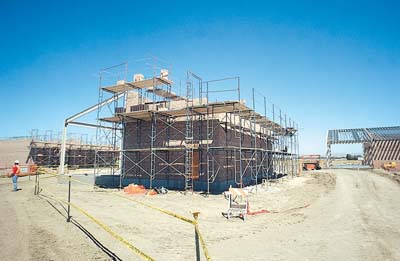Hollister City Council members have been discussing the notion
since they realized the new wastewater treatment plant’s original
bid would come in under budget. That original bid was for around
$55 million, while the current projection is about $20 million less
than that for the plant set for completion this year.
HOLLISTER
Hollister residents might finally get a break on sewage rates in the near future, as officials have contracted with a consultant to study a potential reduction to bills.
Hollister City Council members have been discussing the notion since they found out the new wastewater treatment plant’s original bid would come in under budget. That original bid was for around $55 million, while the current projection is about $20 million less than that for the plant set for completion this year.
City Manager Clint Quilter expects that the city should receive the report from San Francisco-based Stone & Youngberg at the first council meeting in November, but officials aren’t yet sure of the impact on sewer bills. Residents should be pleased with the news, especially considering a July increase that took single-family residential units from about $130 to $180 in July.
“We are working on what we can do with the amount of savings from the project to lower rates,” Quilter told the Free Lance.
Eileen Gallagher, managing director for Stone & Youngberg, said her team should have the numbers done “in the next couple of weeks, hopefully.” She said she’s reviewing the city’s sewer rates to ensure that the plant’s debt is covered.
For a reduction to take place, two criteria must be met. The first is that the covenant of the bond is covered – meaning the issuance covering construction of the wastewater plant has been paid off. The second is that the plant itself is paid off. According to City Finance Director Robert Galvan, the total cost of the plant has not been finalized.
“We are looking into it as we speak,” said Galvan.
Ultimately, there is no definitive decision whether there will be a reduction in rates in the future, Galvan noted.
At the current rate schedule, rates would increase for a single-family home by $68.51 to a semi-monthly total of $248.80.
Councilwoman Monica Johnson said she believes the issue is “extremely important” and she wants the community to see the savings.
Johnson gave some possible scenarios for a rate change. One is that the money saved would go toward a leveling off of future rates. The other is to lower rates now and then raise them gradually again.
Whatever the outcome might be, a point of emphasis from leaders is that the city meet its financial obligations first.
“It might not be what everyone is expecting,” Johnson said. “We can’t jeopardize the plans that we have that we meet all of our obligations financially.”
Councilwoman Pauline Valdivia pointed out that some of her constituents receiving government aid are skipping other needs, such as medication and food, just to make sure they can pay their bills.
Another reason there was an increase in rates, outside of the sewer plant, is that prior city council members had not raised sewer rates for many years, leading to lacking funds being saved in the sewer fund, Johnson noted.
Without funding from that account, the burden of much higher sewer rates rested largely on citizens.










